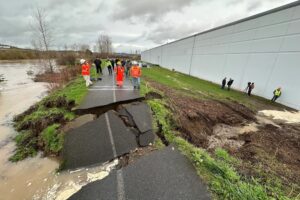PADUCAH, Ky. — Kentucky highway officials say long-haul truck drivers who veer off onto rural roads are creating major problems.
That’s why officials with the Kentucky Transportation Cabinet (KYTC) and Kentucky State Police Division of Commercial Vehicle Enforcement say they are reminding long-haul truck drivers to stay on routes that have been established as appropriate for the weight and size of their vehicles.
KYTC District 1 in Paducah and Kentucky State Police Post 1 in Mayfield have ramped up efforts to deter semi-tractor trailers from attempting shortcuts on rural secondary roads that were not designed for large cross-country trucks, according to a news release, which also noted that the issue is “a common problem across the Commonwealth and neighboring states.”
“This is a recurring issue as drivers try to save on time and fuel,” District 1 Chief District Engineer Kyle Poat said. “But our rural secondary roads were not built for regular through-travel by vehicles of such size and weight.”
The conflict is playing out on roads across the Commonwealth such as KY Hwy 286, which crosses southern Ballard County and forms a cut-through between Wickliffe and Paducah.
“Over the last three years, there have been 119 crashes, 40 injury crashes and 5 fatality crashes along just over 16 miles of KY 286,” the news release noted. “About 30 of the crashes involved a SEMI or “STAA truck,” a reference to the Surface Transportation Assistance Act of 1982. The law established and defined a national truck network of highways and bridges suitable for large trucks. Of the 24 most recent crashes on KY 286, about half involved commercial trucks.”
“NO TRUCK” signs have been installed at each end of KY 286 and at state highway intersections. Commercial Vehicle Enforcement (CVE) officers have also stepped-up patrols and written numerous citations.
When the cases came before the district court, the judge expressed his opinion about the need for signage indicating no trucks. CVE Officer Mark Townsend asked KYTC District 1 for help and “NO TRUCK” signs were installed.
“The signs will help with enforcement efforts as additional cases come up in district court,” Townsend said. “The legal responsibility falls on the CDL-carrying professional driver. The driver is required to follow a route that keeps the truck on the National Truck Network.”
To avoid the restricted section of KY 286, cross-country truckers traveling between Wickliffe and Paducah should follow U.S. 60. The “NO TRUCK” signs and restrictions do not apply to local farmers or trucks making local deliveries along KY 286.
Officials noted that the widespread use of cell phone GPS mapping apps created for passenger vehicles also contributes to semi trucks ending up on inappropriate routes.
“The phone apps lack features that mark low overpasses, denote narrow roadways and other obstacles trucks should avoid, according to the news release.
For example, Poat said long-haul truck drivers following passenger vehicle phone apps are sometimes routed onto the U.S. 45 Ohio River “Brookport” Bridge, which has weight, height and vehicle width restrictions that prohibit commercial trucks. Truckers following cell phone mapping systems often hit a low railroad overpass in Hickman County along KY 307 north of KY 94, despite numerous warning signs. The problem becomes more acute when truckers follow phone apps while attempting to detour around crashes that block major routes.
Poat said truckers could prevent trouble for themselves and other highway users by purchasing a GPS unit or map app specifically programmed to direct over-the-road trucks to the National Truck Network.
KYTC is asking several websites that cater to long-haul truckers to help alert commercial drivers to the hazards of navigating with phone map apps that are not designed for SEMI trucks.
The agency also offered a list of mapping systems and apps that are specifically designed for commercial trucks.
They are:
- Trucker Tools (FREE): https://www.truckertools.com/carriers/trucker-tools-app/Smart Truck Route (FREE): https://www.smarttruckroute.com/ Trucker Path: https://truckerpath.com/
- MileOn: https://mileonapp.com/
- Truckmap: https://truckmap.com/
- TomTom GO Navigation (available truck-specific subscription). https://www.tomtom.com/en_us/navigation/mobile-apps/go-navigation-app/
- Hammer App: https://www.hammerapp.com/
Born in Pine Bluff, Arkansas, and raised in East Texas, John Worthen returned to his home state to attend college in 1998 and decided to make his life in The Natural State. Worthen is a 20-year veteran of the journalism industry and has covered just about every topic there is. He has a passion for writing and telling stories. He has worked as a beat reporter and bureau chief for a statewide newspaper and as managing editor of a regional newspaper in Arkansas. Additionally, Worthen has been a prolific freelance journalist for two decades, and has been published in several travel magazines and on travel websites.
















Good points here, however what about the agriculture side of this? I’ve been on a few roads in Kentucky for agriculture purposes & they were hairy in places. Somebody in the Kentucky State Police should research this as well. Foodstuffs don’t just appear on the shelf.
I ve driven that road 10s of times,I didn t know it was restricted,I ve seen plenty of trucks there too,a little narrow,but very drivable,I really don t see anything wrong with it,there are worse roads,much worse roads than it in Ms,N.C.,W.V. Pa. and those roads in the other states are designated for all traffic.
Ag and local deliveries are permissible in these areas. I’m a truck driver who lives in the Paducah area of west Kentucky and there are wrecks and rollovers on these roads weekly. So it has come down to this unfortunately.
I’ve driven trucks most of my life and many miles in Kentucky. Many roads are narrow and some curves are very tight. Shoulders are dangerously almost non existent. Fuel is cheaper in KY but accidents are costly. Fortunately I never had an accident in KY.
Another reason food and other commodity prices are up. people making rules without fully researching the impact of such decisions